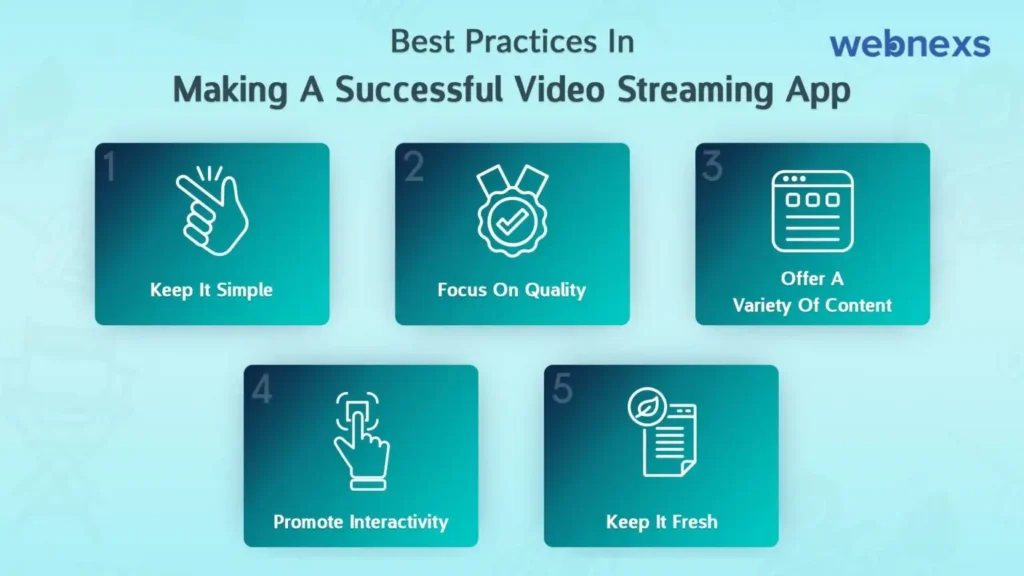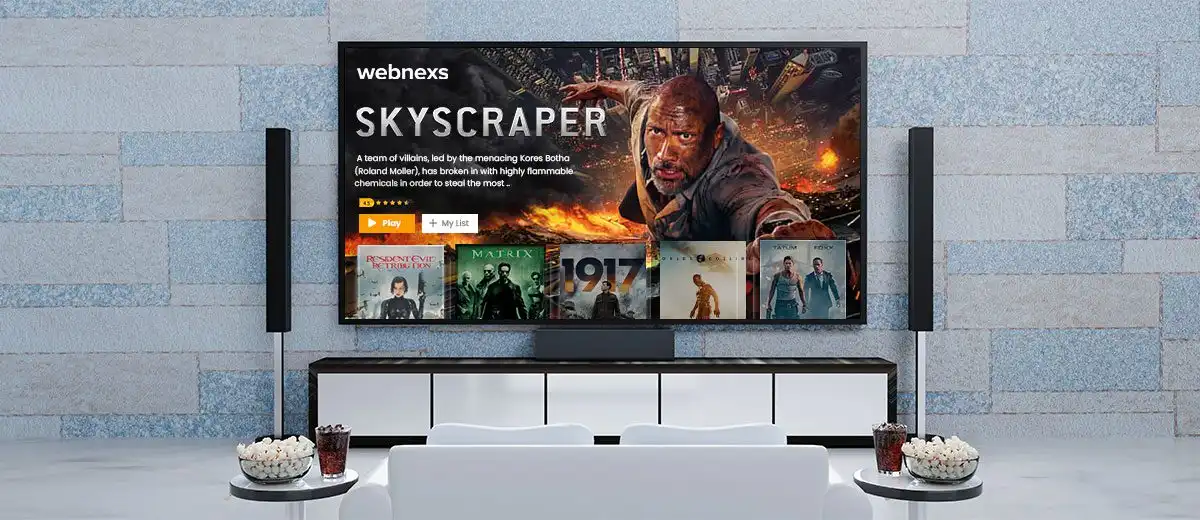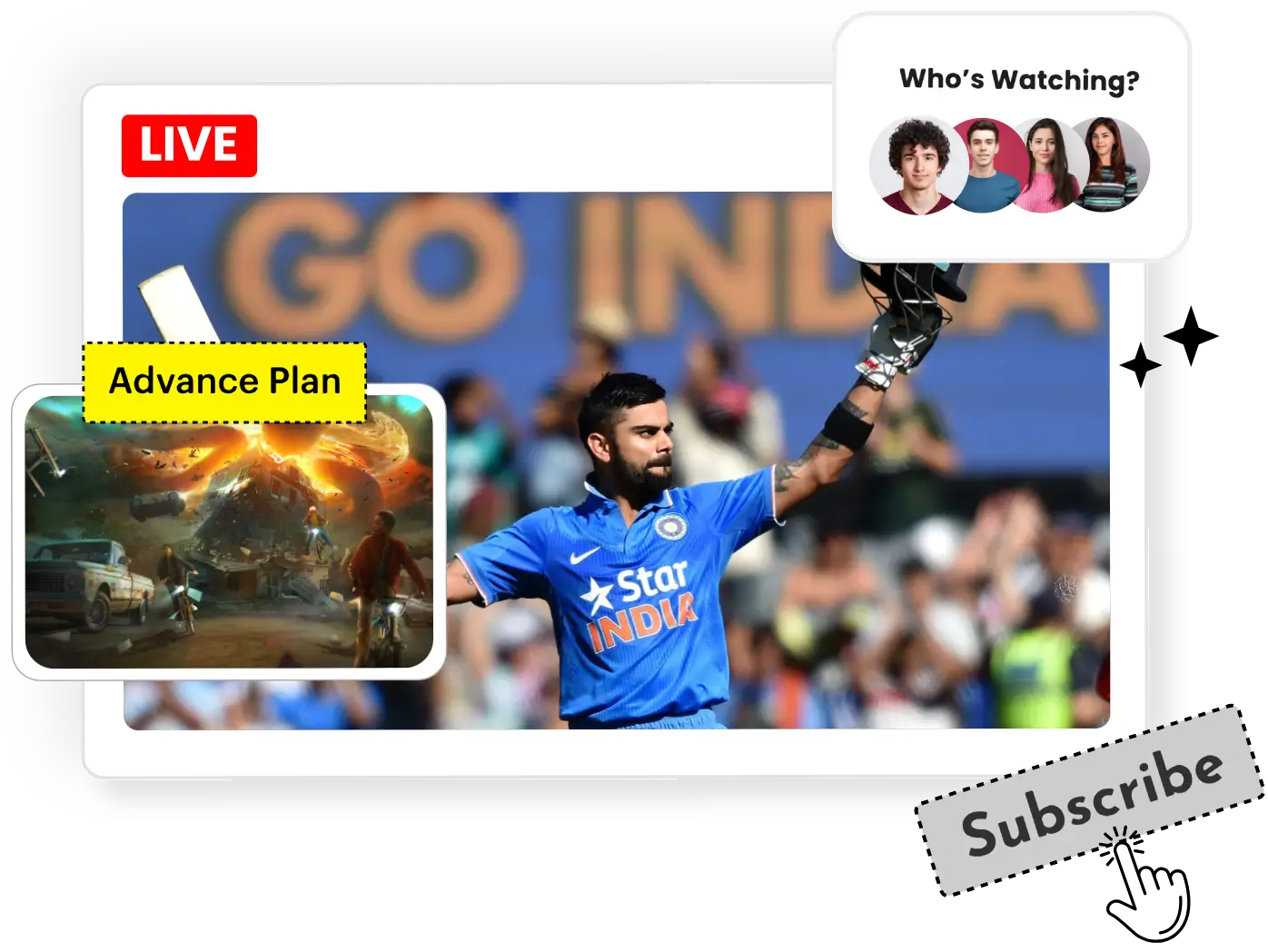Imagine a world without Netflix—no binge-watching, no instant access to favorite shows. Sounds impossible, right?
The overall estimate suggests that the video streaming business will have the highest value of $223.98 billion by 2028, validating that the OTT is the future.
The content sharing through the internet existed even in the absence of streaming services, but now it has reached over 60% of global internet traffic showing the strong user demand for video on-demand content.
Streaming platforms, in example Netflix, Disney+, Prime Video have adopted the latest technology in the media industry which has in a turnover ending to a great achievement of 1.5 billion over-the-top subscribers throughout the globe.
The streaming platform (83%) wins the day in terms of the medium of entertainment internet users prefer over the traditional way of TV broadcasting, a perfect opportunity for a new player in the market.
Creating a Netflix-style app isn’t just about uploading videos—it requires a seamless user experience, strong content delivery, and a smart monetization strategy.
Ready to build your own streaming platform? Let’s dive into the step-by-step process!
What is a Streaming App?
A video on demand app is a type of software application that allows users to watch videos over the internet.
They typically have a wide range of features, including the ability to search for and find specific videos, create and manage playlists, and share them with other users.
Many apps also offer additional features, such as the ability to download for offline viewing, live streaming, and support for high-definition and ultra-high-definition content.
Because of the increased use of cell phones, and other mobile devices, the popularity of this platform has risen in recent years.
It has been reported that all digital video traffic was consumed on mobile devices. As more people view their smartphones and tablets, this trend is only going to grow.
Turn your streaming idea into reality!
Benefits of Creating a Streaming App Like Netflix
High Revenue Potential.
The employment of subscription-based or hybrid monetization models can ensure that a stable and potentially scalable income will be generated.
Wider Audience Reach
Through multi-device support, including smartphones, smart TVs, tablets, and desktops, the app can reach users across the world.
Brand Ownership & Customization
App design, user interface, and features are creating a unique, distinguishable character of your brand.
Flexible Monetization Models
Depending on your audience and business objectives, you can go with SVOD, AVOD, TVOD, or even a mix of several models.
Content Security
The use of digital rights management (DRM) and encryption technologies is extremely useful for protecting your content from illegal use and piracy.
Data-Driven Decisions
Viewing reports provided by analytics solutions and understanding customer behavior can be part of the content optimization and customer retention process.
Scalable Architecture
A scalable, cloud-based technical infrastructure flexibly adjusts to volume changes and content enlargement within the platform.
User Engagement Features
More specifically, push notifications, personalized recommendations, and watchlists are features that can be used to keep the user engaged.
Features and functionality to create a successful video streaming app
Developing a successful video on demand app like Netflix requires more than just packing in cool features. You must also ensure that such features are simple and enjoyable to use, or else your users will become frustrated and go on to something else. Here’s a look at what it takes to create a streaming app like Netflix.
Large selection of high-quality content
It needs to have a large selection of high-quality content in order to be successful. This content can come from a variety of sources, but it must be of high quality in order for people to continue using the app.
Ease of use
It also needs to be easy to use. People should be able to easily find the content they want to watch and start watching it with a few clicks. The app should also be easy to navigate so people can find new content to watch.
Compatibility
It needs to be compatible with a variety of devices in order to be successful. People should be able to watch content on their TV, laptop, smartphone, or tablet. They should also work with a variety of different operating systems so they can be used by everyone, regardless of what type of gadget they have.
Must be affordable
It also needs to be affordable in order to be successful. People should be able to subscribe for a reasonable price and have access to all of the content that they want to watch.
How to Create a Streaming App Like Netflix?
It lets you view movies and television shows on the move. The company has been successful in a way that is easy to use and provides a great user experience. In order to create a streaming app like Netflix, you need to focus on three key areas: content, design, and technology.
1. Idea and Research
Define the Purpose: As far as your platform’s leading element is concerned the focus on the subscription-based content shall make everything clear, but you can opt for another alternative which would include the ad-supported free content if you think it is better.
Market Research: Netflix, Amazon Prime Video, Disney+, and Apple TV+ are very prominent in the market. Research, analysis will give you deep insight into the strengths and weaknesses of these companies.
Audience Analysis: Mention the demographic details of your target audience, in terms of, the content they are inclined to and the geographic area they cover.
2. Planning
Feature List: Develop the list of options that your platform might have (e.g., content streaming, user profiles, content upload payloads, and currency gateways, as well as analytics).
Monetization Model: Come up with the strategy which will be used to obtain money (SVOD, TVOD, AVOD, or a hybrid model).
Tech Stack: Through the selection of the most suitable technologies, for example, cloud services (AWS, Azure, Google Cloud), frontend development frameworks (React, Angular, Vue.js), backend technologies (Node.js, Django, Ruby on Rails) and databases (MongoDB, PostgreSQL) integrate these ones into your applications.
3. Design
UI/UX Design: The main thing is creating an intuitive and minimalized application that allows discovery and playback for the content seamlessly.
Wireframes: Construct wireframes and prototypes in order to outline the user’s journey.
Branding: Formulate an absolutely unique, compelling brand identity in terms of color schemes, logos, typography, and mojo pictures.
4. Development
Frontend Development: Set-up the client-side of the platform using efficient lightweight and latest technologies such as React, Angular, or Vue.js to lay the base for an interactive and dynamic app.
Backend Development: The main part of the server-side functionalities include content management responsive with the user, user authentication, payment processing, and video encoding which are built through cutting-edge technologies like Node.js, Django, or Ruby on Rails.
Database Integration: Establish databases in which the contents, user data, and analytics will be stored. The most common options are MongoDB, PostgreSQL, or MySQL.
Content Delivery: Implement CDNs (Content Delivery Networks) for immediate and reliable content streaming, using tools such as AWS CloudFront, Akamai, or Azure CDN.
5. Content Management
Content Uploading: Facilitate users with tools they can use to upload their own videos and other content.
Metadata Management: Provide your viewers with settings that will allow them to neatly separate and describe videos (tags, descriptions, categories).
6. Content Delivery
Adaptive Streaming: Incorporate smooth streaming methods via protocols like HLS (HTTP Live Streaming) or DASH (Dynamic Adaptive Streaming over HTTP) over multiple wise devices.
CDN Integration: Engage the cloud-based CDNs to ensure crystal-fast delivery and higher rate of efficiency, even in the busiest periods.
7. Monetization Integration
Payment Gateways: Incorporate payment solutions such as Stripe, PayPal, Apple Pay, or any other regional payment providers to let people make transactions in no time.
Subscription Models: Give access to various packages such as monthly, yearly, and first-time customer arrangements that can be distinct as per the customer’s choice out of the option.
8. Testing
Functional Testing: Checking the audio and video playback, search, upload, and payment are all factors which need to be considered when developing apps.
Cross-Platform Testing: The project involves testing the compatibility of different devices, such as smartphones, tablets, smart TVs, and desktops.
Performance Testing: Validate server stability, loading speeds, and content delivery efficiency, as well as quality of video streaming.
9. Deployment
Cloud Infrastructure: You can select the cloud service provider, for instance, AWS, Google Cloud, and Azure, for cost-effective and secure deployment.
Launch: First and foremost, let’s deploy mobile apps for the iOS and Android platform along with the web audience.
10. Post-Launch Support
Analytics and Insights: Install tools like Google Analytics and Mixpanel to determine what your audience likes and what is working correctly in the platform is among the best ways to gauge the success and overlooked/failed features of your solution.
Customer Support: This should include not only ways people can reach you directly, but also trying to fix their problems in an automated way to make things simpler in the first place.
Build a feature-rich streaming app like Netflix.
What type of technology do you need in order to make a live-streaming app?
One of the most popular ways to watch videos these days is through a service like Netflix. But what kind of technology do you need in order to create a Streaming app like Netflix? We will take a look at some of the key components that are necessary for such an app. In the end, you should have a better understanding of how these types of apps work and what it takes to build one.
Server
You’ll need a powerful server infrastructure capable of managing enormous volumes of data traffic to build software. This is because it requires a lot of bandwidth and can quickly overwhelm a server if it’s not properly configured.
Content Delivery Network (CDN)
A Content Delivery Network (CDN) is a collection of servers that work together to provide content. When you create an app, you’ll need to use a CDN in order to ensure that your users can always watch the videos they want, even if there is more traffic on your software.
Video Player
Of course, you’ll also need a video player in order to actually play it on your app. There are many different types of players out there, but you’ll need to choose one that is compatible with the server and CDN that you’re using.
User Interface
Last but not least, you’ll need to create a user interface that is easy to use and allows users to easily find what they want to watch. This can be a challenge, but it’s important to make sure that you are intuitive and easy to navigate.
Monetization Models for Creating a Streaming App Like Netflix
Creating a streaming app like Netflix involves the application of a solid monetization model for revenue generation. Netflix has a subscription-based model (SVOD) but other approaches may also be looked at. Below are some popular monetization models for streaming apps:
1. Subscription-Based Video On Demand (SVOD)
Model: Users pay a recurring fee (monthly or yearly) to access unlimited content without ads.
Revenue: Consistent and predictable income from subscribers.
Pros:
- Stable revenue streams.
- Build customer loyalty, the bond of your product with the customers that buy).
Cons:
- Necessitates to permanently invest in new content in order to keep the users intrigued.
- Variable prices may impair the OA between Churn and customer acquisition.
2. Transactional Video On Demand (TVOD)
Model: Users pay per view or for individual content pieces, such as movies or episodes.
Revenue: Pay-per-use revenue to the certain content pieces.
Pros:
- May attract budget-conscious consumers who are picky about content.
Cons:
- Exactly as SVOD is for Ad Revenue you need to search out other resources for the nonpredictable income.
- On the flip side, subscriptions are easier to use.
3. Ad-Supported Video On Demand (AVOD)
Model: Users don’t have to pay to access content but they are shown ads during the playback of the video.
Revenue: Ad revenue from sponsors
Pros:
- Lower threshold of access for users.
- Generate revenue through ads without forcing user subscriptions.
Cons:
- Anger about ads, in some cases, would make ad-free outlets very attractive.
- Less revenue per user compared to SVOD.
4. Freemium Model
Model: A model that provides restricted access to individuals with a paid subscription, who can then opt to purchase added supplemental features (e.g., more content, ad-free experience, offline viewing).
Revenue: Advertising revenue from basic content and premium memberships for extra value.
Pros:
- Free contents are intended to entrap more users.
- Upsell opportunities through the premium category.
Cons:
- Customers might hang on with the free ones over these rare ones they purchase.
- Pros and cons determine the real success of the upsell conversions.
5. Hybrid Model
Model: A cross between SVOD, TVOD, and AVOD, which gives users multiple options to select from.
Revenue: Monthly/annual subscriptions + PPV + Ad income
Pros:
- It allows more flexibility to cater to the various audiences out there.
- It brings in the maximum profit possible.
Cons:
- The setup is part and parcel of a tedious process thereof.
- Firstly, it should be attention gained from the right sources to avoid pricing mistakes that directly affect the product.
6. Content Licensing and Syndication
Model: A service which content creators offer for rent to some other platforms, in exchange of revenue sharing or fixed fee.
Revenue: Receiving the payment for licensing the content to third-party platforms.
Pros:
- Extra income via emulous liscensing.
- In addition to this, it helps to include powerful promotional events that can, in the end, attract new fans.
Cons:
- The prevailing truth is that a sharp reduction in content is the most vulnerable link.
- Risky enough to break if revolving so much on the external ones.
Want to create a Netflix-like streaming app?
Steps to Implement a Monetization Model in Your Streaming App:
Choose the Right Model: After understanding the characteristics of your target group and your content program,
Content Planning: Make sure that you have generated content that is relevant to your monetization strategy.
For SVOD: Create content that is unique and of good quality.
For AVOD: Consider the fact that the easiest way to monetize your content is by acquiring content with ads.
Payment Gateway Integration: Set up reliable, secure, and fast payment methods such as Stripe, PayPal, and Alipay, that are compliant to your chosen monetization model.
Ad Management: In case of the AVOD, it is advisable to use ad management tools such as Google Ad Manager among others to effectively manage ad placement.
Analytics and Performance Monitoring: Utilize metrics tool (Google Analytics, Mixpanel) to ensure that your decisions are based on hard data. For example, track user engagement, subscription renewals, ad impressions, and content views through the use of anti tools (Google Analytics, Mixpanel) to identify the most profitable source of revenue.
A/B Testing: Regular tests help you to get different price models, content deals, and ad tools which contribute to the experience and revenue for the user.
How much does a streaming app cost, and how long does it take?
In recent years, platforms like Netflix have become extremely popular. So, how much does it cost to make a video content platform? Here is a breakdown of the costs involved in creating such an app.
Development Team
The first cost is the cost of the development team. To develop a high-quality ott platform, you will need a team of experienced developers. The cost of hiring such a team can range from $50,000 to $100,000.
Hosting
The second cost is the cost of hosting the app. It requires a lot of bandwidth and storage space. The cost of hosting can range from $500 to $1000 per month.
Content
The third cost is the cost of the content. To provide users with high-quality content, you will need to license or purchase content from content providers. The cost of licensing or purchasing video content can range from $1000 to $5000.
It takes approximately six to eight months to create a streaming app like Netflix with high quality. The specific time frame depends on the features and functionality included in the app. For example, if the app includes complex features such as social networking or payments, it will take longer to develop. However, if the app is relatively simple, it can be developed in a shorter time frame.
Read More: The Ultimate Guide to Start An OTT Platforms in 5 Simple Steps
Potential challenges and problems while developing a live streaming app?
When you’re developing, there are a few potential problems you might encounter. We will take a look at some of the most common problems and offer some tips on how to fix them.
Whether the app can handle high-quality video
One challenge could be ensuring that your app can handle high-quality videos without buffering or lagging. This is especially important if you’re offering live-streaming content. To fix this, you’ll need to make sure you can handle large amounts of data quickly.
Ensuring good video quality
Another challenge could be ensuring that the video quality is good enough for users to want to watch. This means having a clear and consistent image, as well as a sound that is synced up with the video. If the video quality is poor, users are likely to stop watching and may not come back.
Make sure videos load quickly
Another potential problem is making sure that videos load quickly for users. This can be a challenge if you’re offering high-quality service, as it takes longer to load. To fix this, you can try offering lower-quality video or making sure your server is fast enough to handle the data.
Make sure the app is stable
You always need to make sure that the app is stable and doesn’t crash often. This can be a challenge if you’re offering live streaming content, as it requires more processing power. To fix this, you can use a stronger server or add more resources to the app.
Finding the right hosting solution
Another challenge could be finding the right hosting solution to store and deliver your videos. This is especially important if you’re offering live streaming content, as you’ll need a stable and fast connection. To fix this, you can use a cloud-based hosting solution or a dedicated server.
The app is secure and compliant with all relevant laws and regulations
You’ll also want to make sure that your app is secure and compliant with all relevant laws and regulations. If you’re holding sensitive user data or providing live streaming material, this is critical. To fix this, you can use a secure server or encrypt your data.
Promoting your app
Finally, you’ll need to promote your service to make sure people are aware of it and using it. If you’re not experienced with digital marketing or don’t have a significant budget, this can be difficult. To fix this, you can try using social media or creating a blog post.
These are only a number of the issues you can face when you work on your software. You may avoid potential pitfalls and create a successful platform by being aware of them and planning ahead.
Read More: What is IPTV? An Ultimate Guide to Know About IPTV& its Benefits
Ready to launch your own OTT platform?
What are the best practices for making a successful Streaming Platform?

The answer may surprise you – there’s no one-size-fits-all answer to this question. Every platform is different, and what works for one might not work for another.
If you’re looking to create a streaming app like Netflix, make sure you keep these best practices in mind. With the right strategy, you can create one that users will love.
That said, all successful apps follow a set of best practices, and we’ll go over five of the most significant ones.
Best Practice #01: Keep It Simple
When designing the software, one of the most important things to remember is to make it simple. Users don’t want to be overloaded with choices or features.
Instead, focus on creating an app that is easy to use and has a streamlined interface. This will increase the likelihood of users sticking around and continuing to use your software.
Best Practice #02: Focus on Quality
When it comes to VOD streaming, it’s all about quality. Users want to be able to watch videos that are high-quality and look great.
If your app doesn’t offer quality video content, users will quickly become frustrated and stop using it. Make sure you’re only offering the best of the best in terms of video content.
Best Practice #03: Offer a Variety of Content
Another thing to remember is that users enjoy variety. They don’t want to watch the same types of videos over and over again.
Make sure you’re offering a wide range of content so that there’s something for everyone. This will keep users coming back for more and ensure they stick around for the long haul.
Best Practice #04: Promote Interactivity
In today’s age, users want to be able to interact with the content they’re consuming. They don’t just want to watch videos – they want to engage with them.
One way to promote interactivity is by offering features like comments and ratings. This will give users a way to share their thoughts on the videos they’re watching and help you improve your platform.
Best Practice #05: Keep It Fresh
Finally, it’s important to keep your content fresh. If users see the same things over and over again, they’ll quickly become bored and stop using.
Make sure you’re regularly adding new content so that there’s always something new for users to enjoy. Customers will return for more as a result of this, ensuring their long-term retention.
Real-World Examples of Successful Netflix Alternatives:
Amazon Prime Video
Success: Amazon Prime Video has very popular titles because a wide array of movie, series, and original content avail there. People can subscribe to Amazon Prime membership and log in to their Prime account to access Amazon Prime Video. Additionally, it’s a part of Amazon’s broader ecosystem that makes it really simple for users to run Amazon Prime memberships and watch Amazon Prime Video.
Key Features:
- Rich content catalog (movies, TV shows, Amazon Originals)
- Region and location-specific content
- Multi-device compatibility (smart TVs, mobile, desktop)
- Offline downloads
HBO Max
Success: HBO Max has built a unique niche that entails making high-quality original content, exclusive access to HBO shows, and offering you a great collection of classic movies. The access to the WarnerMedia portfolio strengthens its position within the market.
Key Features:
- HBO exclusives and series are the things you can get only through HBO originals and series
- Stream at a resolutions as high as 720p
- Streaming across multiple platforms is available
- Offline download may be used
Disney+
Success: Disney+ remains so much admired as well as its large number of Disney content which are from a variety of sources like Pixar, Marvel, Star Wars, and National Geographic. It’s animated content that families spend time together with is the platform’s secret of success.
Key Features:
- Wide range of family-friendly content
- Exclusive originals and series
- Streaming across multiple platforms
- Offline viewing
Apple TV+
Strategy: Apple TV+ is easily recognizable with a super minimal approach and one of the best original content, which plays up the simplicity and handiness of it. It can be seamlessly integrated into Apple’s ecosystem along with this making it a preferred choice for Apple Device users.
Main Features:
- Original content from famous creators
- Interconnected devices
- HD resolution streaming
Your Netflix-style app is just a step away! Get a free demo with Webnexs now.
Discover Why Webnexs Is the Ultimate Video Streaming App Builder
With Netflix dominating the streaming video-on-demand (SVOD) market, a competitive platform is essential for the customer.
Webnexs TV, Enterprise, or Service Platforms are the one-stop shop for building a powerful OTT video app like Netflix. Here’s what makes them the top choice:
End-to-End OTT/VOD Platform: From content distribution and management to monetization and multi-device delivery, Webnexs provides a complete solution.
Custom-Built for Your Brand: Via Webnexs, your brand gets branded apps that are customized accordingly to your brand’s colors, fonts, look, feel, and user experience.
Cross-Platform Compatibility: In contrast, through one platform, Webnexs, you will have the opportunity to deploy apps on Android, iOS, Smart TVs, and Roku. All your apps and devices are controlled from the same panel.
Robust Security Features: Webnexs prevents unauthorized access to your content and protects your earnings through DRM technology, watermarking, secure payment gateways, etc.
Flexible Monetization Models: If you decide to proceed with SVOD, TVOD, AVOD, or all at the same time, Webnexs gets you started with the money-making part easily.
Easy CMS and Backend Tools: Simple, fast, and limited only by your imagination, Webnexs content management system (CMS) is user-friendly for content management, and the backend tools are very easy to use.
Advanced Analytics: With advanced analytics tools, use user, content, and viewer behavior insights to drive data-driven decisions such as serving relevant content, creating frequently asked questions, keeping engaged users, etc.
Conclusion
Creating a successful VOD platform is no easy task. There are numerous considerations to make if you want to design an app that people will enjoy.
If you follow the best practices outlined in this blog post, you’ll be well on your way to create a streaming app like Netflix successfully. Keep these tips in mind and you’ll be sure to create an app that users will love.




14 Responses
Thanks for this amazing blog, it gives more information about video streaming apps.
Good insight on the complete guide of video streaming application
It’s very useful to get more knowledge about video streaming applications, may I know the cost of the application.
In this article, you will learn about video streaming software. This article is very useful and informative for everyone. This article should be read by everyone. I really enjoyed reading this article.
HI. I read your blog, it’s really great, and need this software at an affordable price.
Hii Nandini I already have this application, I read your blog fully its interesting, I want some changes in my software could you help me..
I want to know more about your services and the prices of the software
Hii…I am having an idea based on video streaming software, I read this blog, it’s very useful to me… thank you
I was given sufficient thoughts approximately this software. Thanks for this blog.
Nowadays increase the mobile users as well as this software also like Netflix, I decide to buy this video streaming application to develop my channel… May I know the cost of the software?
Hello…
I read your blog… the content is really good and I get more innovative things about video streaming apps.
Hii… I like to read this blog specifically the portion “what areThe Best Practices In Making A Successful Video Streaming App” this portion. thanks for it
What an amazing blog!
This is some awesome thinking!